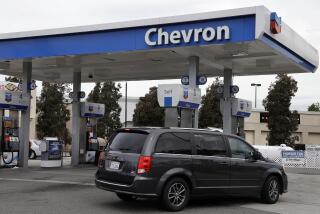Chevron Plans $320-Million Writeoff on Oil Properties; Global Price Slump Blamed
- Share via
SAN FRANCISCO — Chevron, citing the decline in world oil prices, said Wednesday that it will write off about $320 million during the fourth quarter as a result of a five-month-long reappraisal of its oil and gas properties around the world.
The writeoff, which amounts to 94 cents per share, will likely force Chevron to report a loss for the period. Before the announced writeoff, securities analysts’ estimates of Chevron’s net income for the period had ranged from 38 cents to 80 cents a share. The mean estimate was 60 cents a share.
In the fourth quarter last year, Chevron reported net income of $601 million, or $1.75 a share, on revenue of $10.7 billion.
Chevron, which is the nation’s fourth-largest oil company in terms of revenue, said the writeoff related primarily to wells-in-progress and unproven leases, as opposed to properties that are already producing oil and gas.
Not Economic to Develop
The properties written off were deemed “not economic to develop under current conditions,” Chevron said. “We looked especially closely at wells whose production would have required investments in pipelines or offshore platforms,” a spokesman said.
The writeoff includes properties in the United States, Canada, Europe, Africa and Southeast Asia, the spokesman added, “with Africa being the most significant geographical area involved.”
In Africa, Chevron has operations in Angola, Nigeria, the Sudan, Chad and Zaire.
The writeoff, the spokesman said, doesn’t necessarily mean that the wells in question will be abandoned. Rather, he said, “it is just that we can no longer justify carrying them as assets on our books,” adding, “we anticipate that we will pursue the development of some of these properties at a future date.”
The writeoff includes exploratory and drilling expenses that had been capitalized, or treated as assets for bookkeeping purposes.
The special study that concluded that the writeoff was necessary began in July and stretched until early December. It was conducted by operational and accounting specialists from each of Chevron’s operating companies.
Steep Price Decline
West Texas intermediate crude oil, the benchmark variety produced in the United States, has been selling for about $15 a barrel for immediate delivery, compared to $25.20 a year ago.
Arabian light, the Organization of Petroleum Exporting Countries’ benchmark, has fallen even further, to a current spot price of $11.64 a barrel from $27.95 a year ago.
Through the first nine months of 1986, Chevron has posted net income of $801 million, or $2.34 a share, off 15% from the year earlier’s $946 million, or $2.77 a share.
Despite the writeoff, Chevron’s 60-cent-a-share quarterly dividend isn’t in immediate jeopardy. Chevron Chairman and Chief Executive George Keller has said that it would take more than one bad quarter for him to consider recommending a cut in the payout to shareholders.
More to Read
Inside the business of entertainment
The Wide Shot brings you news, analysis and insights on everything from streaming wars to production — and what it all means for the future.
You may occasionally receive promotional content from the Los Angeles Times.










